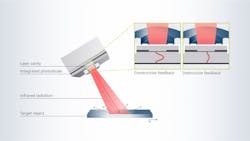Full sensor functionality integrated into tiny VCSELs
Vertical-cavity surface-emitting lasers (VCSELs) as a light source are an established solution for proximity sensing for smartphones, face recognition in security systems, or under OLED display sensing solutions. Now, the robust and compact laser diodes are on their way to conquer new demanding application fields such as eye-tracking in augmented reality/virtual reality (AR/VR) goggles.
VCSEL technology makes use of already-established technologies to integrate additional functions into the laser diode. One example is a VCSEL with integrated photodiode (ViP). Smart ViP devices feature a photodiode structure embedded in the VCSEL resonator so the component not only emits light, but offers the option to detect back-scattered light—providing full sensor functionality. In this setup, a single intracavity contact serves as VCSEL cathode as well as photodiode anode.
TRUMPF developed the first generation of this advanced solution more than 15 years ago, and has since sold many tens of millions of ViP devices.
Looking into the VCSEL
The VCSEL solution is single-mode and comes with an emission wavelength of around 850 nm and a subwavelength grating on its output facet, which is used to stabilize the polarization of emitted light. The ultracompact chip has two separately addressable mesas (see Fig. 1).
The ViP is not only the most compact concept for the integration of a photodiode, but offers several advantages. First, the photodiode is placed around an antinode of the standing wave pattern of the laser radiation. This makes it especially sensitive to laser radiation and less sensitive to spontaneous emission or environmental light. Second, the VCSEL resonator is a very narrow optical bandpass filter, which further reduces environmental background light by orders of magnitude. Third, the photodiode position in the distributed Bragg reflector (DBR) can be fine-tuned to tailor the amount of light on the photodiode vs. the outcoupled light.
For self-mixing interference (SMI) sensing, this enables optimization of the signal-to-noise ratio (SNR). In this concept, a single contact acts as the laser cathode as well as the photodiode anode. The photodiode needs to be operated in reverse bias mode, so the bottom DBR consists of three parts, with the middle part changing polarity (doping) halfway. This allows use of the usual n-doped gallium arsenide (GaAs) substrates. An additional parasitic np-diode in the DBR is operated in forward direction. The little extra voltage is compensated by the space savings enabled by having a single contact. Measurements confirm that laser output power and photodiode current are stable within 10% for more than 4000 hours. The complete ViP behaves like a standard VCSEL at 850 nm, and the design of the ViP comes with a redundant mesa that enables doubling its lifetime. A degradation of one mesa can be detected by the module ASIC, based on the readout of the photodiode, and the current can be switched to the neighboring mesa.
ViP: An enabler for self-mixing interference technology
At the self-mixing interference (SMI) principle, reflected laser light re-enters the laser cavity and interferes with the standing wave. Depending on the phase of the feedback, it can weaken or strengthen the laser amplitude that is monitored with a photodiode or via the laser voltage (see Fig. 2). Therefore, the ViP is the key enabler for the SMI technology, because it both emits light as a VCSEL light source and detects light by the photodiode.To maximize the feedback, the laser aperture is imaged on a target object with a lens. The method works best on a well-defined point. If lower SNR is acceptable, it works over a larger depth range and in the vicinity of the focus point. If the light gets scattered back by a moving object, the feedback radiation has a frequency shifted by the Doppler effect. And laser amplitude will be modulated with a beat frequency, which is a measure for the target’s velocity.
A simple trick helps to measure the distance between the laser and reflecting object: Modulating the laser current with a triangle function leads to a modulated internal temperature of the laser, and therefore a modulated wavelength. The larger the wavelength shift of the feedback, the more distant an object is.
SMI measurements offer outstanding accuracy at the 0.1% level over a wide range of velocities (10-4 to 102 m/s). The measurement method competes with laboratory class instruments, but is considerably smaller and at significantly lower cost. Such accuracy is realized in a remote, touchless measurement and works on almost any surface. SMI technology is insensitive to environmental light, not originating from the laser sensor itself. And the SMI laser stays below the eye-safe limits—an ideal working range for this sensing technology is around a half-meter.
Keep your eyes safe
The next mass applications for the ViP technology platform will be AR/VR glasses. Eye tracking is a well-known technique to analyze the behavior of a test person. In AR applications, information about which object the user is looking at helps to improve 3D experience and to avoid visual discomfort.
It can also be used as user input like an eye-gesture sensor, triggering actions by staring at an object or blinking. Recently, AR goggles for consumer applications were introduced and are increasing the need for lightweight, compact, and affordable sensors (see Fig. 3).Until now, eye tracking was based on imaging techniques, and data rate and signal processing resulted in a tradeoff between low latency and energy consumption. But especially during fast saccades (rapid movement of both eyes that abruptly shifts your focus), the possibility of directly measuring the speed of the eye movement would be beneficial, and SMI-based VCSEL technology offers clear advantages here.
Due to the introduced Doppler effect, SMI technology can sense the speed-vector of the rotating eye at the point of interaction with the laser. Speed readings can be updated between 5 kHz to 50 kHz. For this reason, SMI allows very low-latency measurements below 1 ms. Also, insensitivity to environmental light is an advantage for AR or VR applications, because it enables their use in smart goggles in full sunlight.
Another advantage of the SMI sensing principle is that it can be miniaturized into an integrated and very compact solution based on ViP, optics, and ASIC. Eye safety is, of course, also a requirement in AR/VR applications; the VCSEL laser source comes with laser class 1. This makes the solution ideal for near-to-eye applications with limited available space.
ViP solutions in our daily lives
ViP components enable the combination of velocity and distance sensing, so versatile user interfaces can be addressed. The VCSEL-based SMI technology addresses a wide range of applications because hardware and algorithms can be adapted to the requirements of a specific application.
For example, a highly accurate laser mouse using SMI has been around for more than a decade. Industrial environment rotary encoders to measure movements of a workpiece, for example, are replaced by optical encoders. Particularly on delicate materials, a touchless measurement principle is more reliable. Optical solutions work on all sorts of scattering surfaces such as tire, textile, cardboard, and food, and with any background light at a working distance of 50 mm.
An optical encoder solution from SICK was developed in close cooperation with TRUMPF for contactless and highly accurate measurement of speed and displacement (see Fig. 4). The contactless sensor is based on the SMI approach, and uses two ViP lasers. The use of two VCSEL components with opposite inclination helps to compensate the error from the unknown angle toward the surface and to mitigate the influence of speckles.Particle measurement (PM2.5 or smaller) within the air is another established application field. Until now, sensors have been too large for mobile devices or Internet-of-Things solutions. Traditional particle detectors control and enforce an air flow by built-in fan, which means there are also venting holes and ventilation noise.
On the other hand, a sensor solution based on ViP and SMI is much smaller and can be easily integrated into consumer products as wearables. The sensor module operates from inside the product, fully covered, sealed and absolutely maintenance-free, so no openings in the housing are required. Bosch Sensortec recently introduced the world’s smallest particle sensor, which was developed in close cooperation with TRUMPF. It can measure particle speed and concentration by passing near the detection focus. The module is robust against sunlight, water, and scratches on its glass cover.
ViP combines the unique properties of VCSELs as compact, robust, and eye-safe light sources with integrated sensor functionalities. This can revolutionize applications from consumer electronics to industrial 3D sensing.
About the Author
Holger Mönch
Senior Expert of Product Management, TRUMPF Photonic Components
Dr. Holger Mönch is senior expert of product management at TRUMPF Photonic Components (Ulm, Germany).



